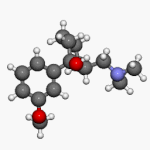Tramadol
Tramadol (Ultram, Tramal) je centralno delujući analgetik i koristi se u lečenju umerenog do umereno jakog bola. Lek ima širok spektar delovanja, uključujući i tretman za sindrom nemirnih nogu, kiselina refluks, i fibromijalgija. Razvijen je od strane farmaceutske kompanije Grünenthal GmbH krajem 70-ih godina 20. veka.[6]
 | |||
| |||
| IUPAC ime | |||
|---|---|---|---|
2-[(Dimetilamino)metil]-1-(3-metoksifenil)cikloheksanol | |||
| Klinički podaci | |||
| Prodajno ime | Ultram, Zytram.[2] | ||
| Drugs.com | Monografija | ||
| MedlinePlus | a695011 | ||
| Podaci o licenci | |||
| Kategorija trudnoće | |||
| Opojna droga | postoji.[1] | ||
| Način primene | oralno, IV, IM, rektalno | ||
| Pravni status | |||
| Pravni status |
| ||
| Farmakokinetički podaci | |||
| Bioraspoloživost | 70–75% (oralno), 77% (rektalno), 100% (IM)[3] | ||
| Vezivanje proteina | 20%[4] | ||
| Metabolizam | Jetrom-posredovana demetilacija i glukuronidacija posredstvom CYP2D6 & CYP3A4[3][4] | ||
| Poluvreme eliminacije | 6.3 ± 1.4 h[4] | ||
| Izlučivanje | Urin (95%)[5] | ||
| Identifikatori | |||
| CAS broj | 27203-92-5 | ||
| ATC kod | N02AX02 (WHO) | ||
| PubChem | CID 33741 | ||
| DrugBank | DB00193 | ||
| ChemSpider | 31105 | ||
| UNII | 39J1LGJ30J | ||
| KEGG | D08623 | ||
| ChEBI | CHEBI:9648 | ||
| ChEMBL | CHEMBL1066 | ||
| Hemijski podaci | |||
| Formula | C16H25NO2 | ||
| Molarna masa | 263.4 g/mol | ||
| |||
| |||
Tramadol dejstvuje kao slab agonist na μ-opioidnom receptoru, oslobađa serotonin, i inhibira reapsorpciju norepinefrina.[7][8][9][10][11][12][13]
Reference
uredi- ^ „Tramadol Hydrochloride”. The American Society of Health-System Pharmacists. Pristupljeno 1. 12. 2014.
- ^ Drugs.com International names for tramadol Page accessed April 23, 2016
- ^ a b Brayfield, A, ur. (13. 12. 2013). „Tramadol Hydrochloride”. Martindale: The Complete Drug Reference. Pharmaceutical Press. Pristupljeno 5. 8. 2014.
- ^ a b v „Ultram, Ultram ER (tramadol) dosing, indications, interactions, adverse effects, and more”. Medscape Reference. WebMD. Pristupljeno 28. 11. 2013.
- ^ „PRODUCT INFORMATION Tramadol SANDOZ 50 mg capsules” (PDF). TGA eBusiness Services. Sandoz Pty Ltd. 4. 11. 2011. Pristupljeno 6. 4. 2014.
- ^ US patent 3652589, Flick, Kurt; Frankus, Ernst, "1-(m-Substituted Phenyl)-2-Aminomethyl Cyclohexanols", odobren 28. 3. 1972.
- ^ Dayer, P; Desmeules, J; Collart, L (1997). „Pharmacology of tramadol”. Drugs. 53 Suppl 2: 18—24. PMID 9190321. doi:10.2165/00003495-199700532-00006.
- ^ Lewis, KS; Han, NH (1997). „Tramadol: a new centrally acting analgesic”. American journal of health-system pharmacy. 54 (6): 643—52. PMID 9075493.
- ^ WO patent 2007070779, Singh, Chandra, "A Method to Treat Premature Ejaculation in Humans", odobren 21. 6. 2007.
- ^ Driessen B, Reimann W (1992). „Interaction of the central analgesic, tramadol, with the uptake and release of 5-hydroxytryptamine in the rat brain in vitro”. British Journal of Pharmacology. 105 (1): 147—51. PMC 1908625 . PMID 1596676.
- ^ Bamigbade TA, Davidson C, Langford RM, Stamford JA (1997). „Actions of tramadol, its enantiomers and principal metabolite, O-desmethyltramadol, on serotonin (5-HT) efflux and uptake in the rat dorsal raphe nucleus”. British Journal of Anaesthesia. 79 (3): 352—6. PMID 9389855.
- ^ Reimann W, Schneider F (1998). „Induction of 5-hydroxytryptamine release by tramadol, fenfluramine and reserpine”. European Journal of Pharmacology. 349 (2-3): 199—203. PMID 9671098. doi:10.1016/S0014-2999(98)00195-2.
- ^ Gobbi M; Moia M; Pirona L; et al. (2002). „p-Methylthioamphetamine and 1-(m-chlorophenyl)piperazine, two non-neurotoxic 5-HT releasers in vivo, differ from neurotoxic amphetamine derivatives in their mode of action at 5-HT nerve endings in vitro”. Journal of Neurochemistry. 82 (6): 1435—43. PMID 12354291. doi:10.1046/j.1471-4159.2002.01073.x.

